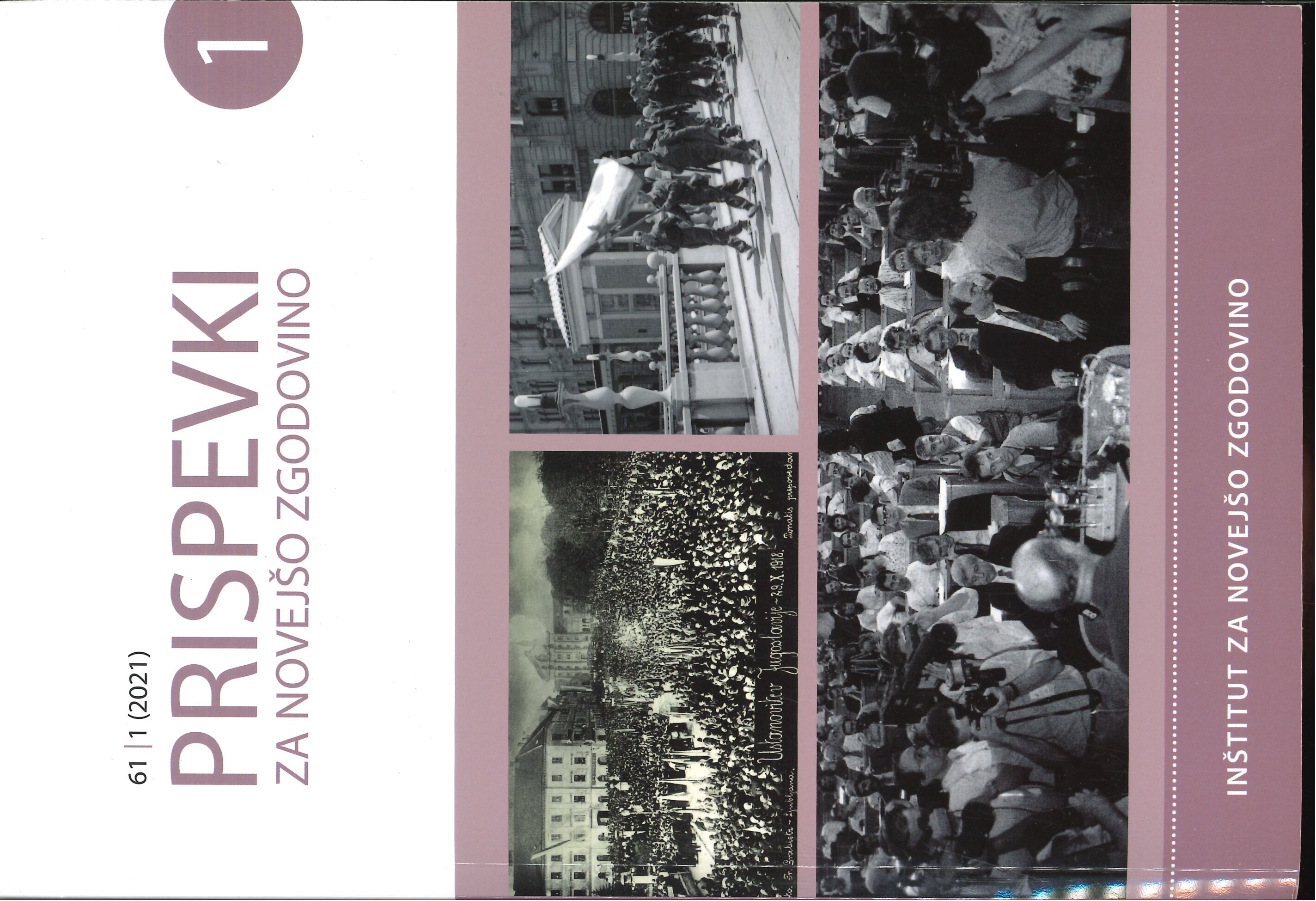Three Times: The Sequence of Historical Events Leading to the Slovenian Statehood in the 20th Century
DOI:
https://doi.org/10.51663/pnz.61.1.01Keywords:
Slovenia, state, politics, self-determination, Yugoslavism, SlovenismAbstract
The Slovenian state was formed in the “short” 20th century". Slovenians have attained the state that they now live in gradually, in three steps (in 1918, 1941–45, and 1990–91). The formation of the Slovenian statehood involved cohesion, a sequence of events. Without the attainment of the initial Slovenian statehood, the second step would not have taken place, while the third stage would have been particularly impossible without the second one. Each of the steps towards the establishment of the Slovenian statehood occurred in its own period, subject to various conditions that influenced the process of the creation of the Slovenian state and the degree of its independence. The first step was taken at the end of World War I, after the state-legal ties with the Austro-Hungarian state had been severed due to the international political circumstances and Slovenians joined the State of Slovenes, Croats, and Serbs. This state then “merged” with the Kingdom of Serbia to form the Kingdom of Serbs, Croats, and Slovenes (as of 1929, the Kingdom of Yugoslavia). The second step took place during World War II, after the former Yugoslav state had collapsed and needed to be restored in new circumstances and with a different organisation – which was, during the war, the goal of the so-called bourgeois political camp, the traditional Slovenian political parties, as well as the so-called revolutionary camp or the liberation movement. The third step, however, occurred when the Yugoslav state, organised in accordance with the criteria of the liberation movement that had prevailed during the war, outlived its purpose. All three steps shared the same goal, while the manners of attaining statehood and the attitude towards it varied, depending on the situation and relations between the factors or proponents of statehood as well as on its political or social agents. The formation of the Slovenian statehood in the “short 20th century” was related to the right to self-determination. This right represented the means or the foundation for the construction of statehood during each phase and was understood somewhat differently during each of the stages of the Slovenian statehood’s formation. Self-determination was an essential condition that made it possible for Slovenians to attain their own state at all –during all three stages of its creation.
References
Balkanski Babilon: raspad Jugoslavije od Titove smrti do Miloševićeva pada. Zagreb: Alinea, 2005.
Balkovec, Bojan. Prva slovenska vlada 1918–1921. Ljubljana: Znanstveno in publicistično središče, 1992.
Čepič, Zdenko, Damijan Guštin in Nevenka Troha. Slovenija v vojni 1941–1945. Ljubljana: Modrijan, 2017.
Ćosić, Dobrica. Piščevi zapisi: (1951–1968). Beograd: Filip Višnjić, 2001.
Ćosić, Dobrica. Piščevi zapisi: (1969–1980). Beograd: Filip Višnjić, 2001.
Hobsbawm, Eric. Čas skrajnosti: svetovna zgodovina 1914–1991. Ljubljana: Znanstveno in publicistično središče, 2000.
Kristan, Ivan. »Pravica do samoodločbe.« V : Zbornik znanstvenih razprav. Ljubljana: Pravna fakulteta, 1990.
Perovšek, Jurij. Samoodločba in federacija: slovenski komunisti in nacionalno vprapanje 1920–1941. Ljubljana: Inštitut za novejšo zgodovino, 2012.
Perovšek, Jurij. Slovenska osamosvojitev v letu 1918: študija o slovenski državnosti v državi Slovencev, Hrvatov in Srbov. Ljubljana: Modrijan, 1998.
Perovšek, Jurij. Slovenski prevrat 1918: položaj Slovencev v Državi Slovencev, Hrvatov in Srbov. Ljubljana: Inštitut za novejšo zgodovino, 2018.
Perovšek, Jurij. »Slovenski komunisti in vprašanje makedonskega naroda leta 1923.« Prispevki za zgodovino delavskega gibanja 18/19, št. 1-2 (1978/1979): 17–44.
Pleterski, Janko. Knjiga pisem: razmišljanje o slovenski državnosti. Ljubljana: Sophia, 2017.
Pleterski, Janko. Narodi, Jugoslavija, revolucija. Ljubljana: Komunist, 1986.
Pleterski, Janko. Pravica in moč za samoodločbo: med Metternichom in Badinterjem: študije, razgledi, preudarki iz petnajstletja po tretji odločitvi Slovencev. Ljubljana: Modrijan, 2008.
Pleterski, Janko. Prva odločitev Slovencev za Jugoslavijo: politika na domačih tleh med vojno 1941–1918. Ljubljana, Slovenska matica, 1971.
Rahten, Andrej. Zavezništvo in delitve: razvoj slovensko-hrvaških političnih odnosov v habsburški monarhiji 1848–1918. Ljubljana, Nova revija, 2005.
Ramet, Sabrina P. Balkan Babel: politics, culture, and religion in Yugoslavia. Oxford: Westview Press, 1992.
Ramet, Sabrina P. Nationalism and Federalism in Yugoslavia, 1962–1991. Indianapolis: Indiana University Press, 1992.
Ramet, Sabrina P. Tri Jugoslavije: izgradnja države i izazov legitimacije, 1918.–2005. Zagreb: Golden marketing-Tehnička knjiga, 2009.
Repe, Božo. Jutri je nov dan: Slovenci in razpad Jugoslavije. Ljubljana: Modrijan, 2002.
Slovenci in država: zbornik prispevkov z znanstvenega posveta na SAZU (od 9. do 11. novembra 1994). Ljubljana: Slovenska akademija znanosti in umetnosti, 1995.
Slovenska novejša zgodovina: od programa Zedinjena Slovenija do mednarodnega priznanja Republike Slovenije: 1848–1992. Ljubljana: Mladinska knjiga in Inštitut za novejšo zgodovino, 2006.
Stiplovšek, Miroslav. Banski svet Dravske banovine: 1930–1935: prizadevanja banskega sveta za omilitev gospodarsko-socialne krize in razvoj prosvetno-kulturnih dejavnosti v Sloveniji ter za razširitev samoupravnih in upravnih pristojnosti banovine. Ljubljana: Znanstveno raziskovalni inštitut Filozofske fakultete, 2006.
Stiplovšek, Miroslav. »Prizadevanja ljubljanske in mariborske oblastne skupščine ter banskega sveta Dravske banovine za udejanjenje slovenskega parlamentarizma v prvi Jugoslaviji.« Zgodovinski časopis 62, št. 1-2 (2008): 151–76.
Miroslav Stiplovšek. Slovenski parlamentarizem 1927–1929. Ljubljana: Znanstveni inštitut Filozofske fakultete, 2000.
Taylor, Alan John Percival. Habsburška monarhija 1809–1918: zgodovina avstrijskega cesarstva in Avstro-Ogrske. Ljubljana: Državna založba, 1956.
Downloads
Published
Issue
Section
License
Authors who publish with this journal agree to the following terms:
- Authors retain copyright and grant the journal right of first publication with the work simultaneously licensed under a Creative Commons Attribution License that allows others to share the work with an acknowledgement of the work's authorship and initial publication in this journal.
- Authors are able to enter into separate, additional contractual arrangements for the non-exclusive distribution of the journal's published version of the work (e.g., post it to an institutional repository or publish it in a book), with an acknowledgement of its initial publication in this journal.
- Authors are permitted and encouraged to post their work online (e.g., in institutional repositories or on their website) prior to and during the submission process, as it can lead to productive exchanges, as well as earlier and greater citation of published work (See The Effect of Open Access).


